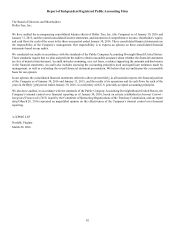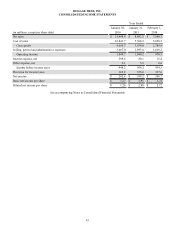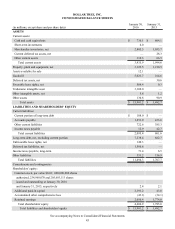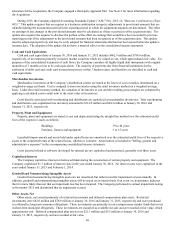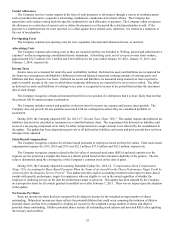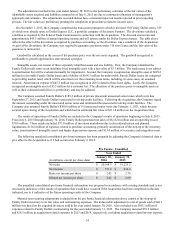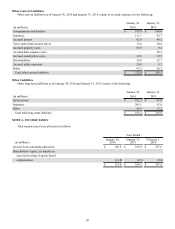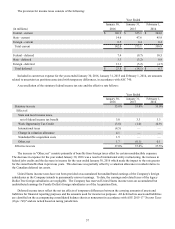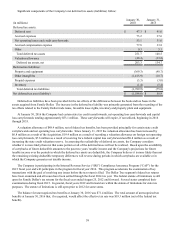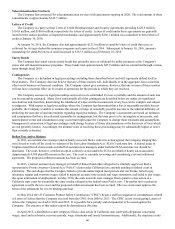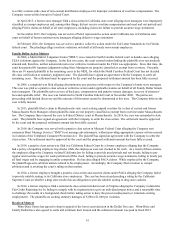Dollar Tree 2015 Annual Report Download - page 68
Download and view the complete annual report
Please find page 68 of the 2015 Dollar Tree annual report below. You can navigate through the pages in the report by either clicking on the pages listed below, or by using the keyword search tool below to find specific information within the annual report.52
Vendor Allowances
The Company receives vendor support in the form of cash payments or allowances through a variety of reimbursements
such as purchase discounts, cooperative advertising, markdowns, scandowns and volume rebates. The Company has
agreements with vendors setting forth the specific conditions for each allowance or payment. The Company either recognizes
the allowance as a reduction of current costs or defers the payment over the period the related merchandise is sold. If the
payment is a reimbursement for costs incurred, it is offset against those related costs; otherwise, it is treated as a reduction to
the cost of merchandise.
Pre-Opening Costs
The Company expenses pre-opening costs for new, expanded, relocated and rebannered stores, as incurred.
Advertising Costs
The Company expenses advertising costs as they are incurred and they are included in "Selling, general and administrative
expenses" on the accompanying consolidated income statements. Advertising costs, net of co-op recoveries from vendors,
approximated $32.5 million, $18.1 million and $14.9 million for the years ended January 30, 2016, January 31, 2015, and
February 1, 2014, respectively.
Income Taxes
Income taxes are accounted for under the asset and liability method. Deferred tax assets and liabilities are recognized for
the future tax consequences attributable to differences between financial statement carrying amounts of existing assets and
liabilities and their respective tax bases. Deferred tax assets and liabilities are measured using enacted tax rates expected to
apply to taxable income in the years in which those temporary differences are expected to be recovered or settled. The effect
on deferred tax assets and liabilities of a change in tax rates is recognized in income in the period that includes the enactment
date of such change.
The Company recognizes a financial statement benefit for a tax position if it determines that it is more likely than not that
the position will be sustained upon examination.
The Company includes interest and penalties in the provision for income tax expense and income taxes payable. The
Company does not provide for any penalties associated with tax contingencies unless they are considered probable of
assessment.
During 2015, the Company adopted ASU No. 2015-17, "Income Taxes (Topic 740)." This update requires that deferred tax
liabilities and assets be classified as noncurrent in a classified balance sheet. The requirement that deferred tax liabilities and
assets of a tax-paying component of an entity be offset and presented as a single amount is not affected by the amendments in
the update. The update has been adopted prospectively to all deferred tax liabilities and assets and prior periods have not been
retrospectively adjusted.
Stock-Based Compensation
The Company recognizes expense for all share-based payments to employees based on their fair values. Total stock-based
compensation expense for 2015, 2014 and 2013 was $52.3 million, $37.4 million and $36.2 million, respectively.
The Company recognizes expense related to the fair value of restricted stock units (RSUs) and stock options over the
requisite service period on a straight-line basis or a shorter period based on the retirement eligibility of the grantee. The fair
value is determined using the closing price of the Company’s common stock on the date of grant.
During 2015, the Company adopted Accounting Standards Update No. 2014-12, "Compensation-Stock Compensation
(Topic 718): Accounting for Share-Based Payments When the Terms of an Award Provide That a Performance Target Could be
Achieved after the Requisite Service Period." This update provides explicit accounting treatment with respect to share-based
awards with specific performance targets for employees who are eligible to vest in the award regardless of whether the
employee is rendering service on the date the performance target is achieved. This update has been adopted by the Company
on a prospective basis for all awards granted or modified on or after February 1, 2015. There was no impact upon the adoption
of the update.
Net Income Per Share
Basic net income per share has been computed by dividing net income by the weighted average number of shares
outstanding. Diluted net income per share reflects the potential dilution that could occur assuming the inclusion of dilutive
potential shares and has been computed by dividing net income by the weighted average number of shares and dilutive
potential shares outstanding. Dilutive potential shares include all outstanding stock options and unvested RSUs after applying
the treasury stock method.


